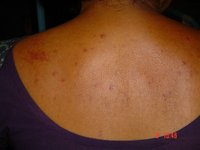MYTH: Idiopathic thrombocytopenic purpura (ITP) is caused by abnormalities in the bone marrow.
FACT: An autoimmune bleeding disorder, ITP develops when antibodies destroy platelets in the periphery of the body, rather than in the liver or spleen, as normal. The resulting low platelet count causes bruising, petechiae, and abnormal bleeding. Severity of illness depends on the location, duration, and amount of bleeding.
MYTH: Because ITP is hereditary, genetic counseling is recommended.
FACT: Neither of the two types of ITP-acute in children and chronic in adults-has a genetic link.
MYTH: Acute ITP in children is often fatal.
FACT: About 50 children per million develop acute ITP annually; 83% recover spontaneously without treatment within 2 months. Only about 2% die. Onset of acute ITP often follows a viral illness or live virus vaccination.
MYTH: Bone marrow aspiration is standard to confirm a suspected ITP diagnosis.
FACT: Bone marrow aspiration is appropriate in children if thrombocytopenia persists despite treatment, but it's not a routine diagnostic procedure for ITP. The diagnosis of ITP is primarily based on the patient's history, physical exam, complete blood cell count, and examination of a peripheral blood smear. These results should rule out other possible causes of thrombocytopenia.
MYTH: Splenectomy is the first choice of treatment for ITP.
FACT: Splenectomy isn't indicated for patients with mild symptoms. However, Splenectomy may be appropriate if bleeding is severe or persistent and the patient's platelet count remains below 30,000/mm^sup 3^ after 6 weeks of medical therapy.
Most patients with platelet counts below 50,000/mm^sup 3^ are prescribed glucocorticoids, such as prednisone and methylprednisolone, and I.V. immune globulin to reduce inflammation and increase platelet count. Patients with platelet counts above 50,000/mm^sup 3^ and those with counts above 30,000/mm^sup 3^ who are asymptomatic or have only minor purpura may not need treatment.
BY BECKY LIEN MUNSON, RN
Becky Lien Munson is nursing supervisor at the Washington School for the Deaf in Vancouver, Wash. Selected references for this article are available on request.
Copyright Springhouse Corporation Nov 2004
Provided by ProQuest Information and Learning Company. All rights Reserved



